



 |  |  | |||||||
 |
Home | Newsletters | Links | Train Simulator | |||||
Overview |
Technical |
Scenarios |
Offer |
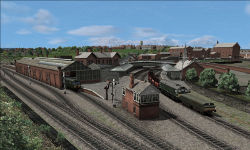
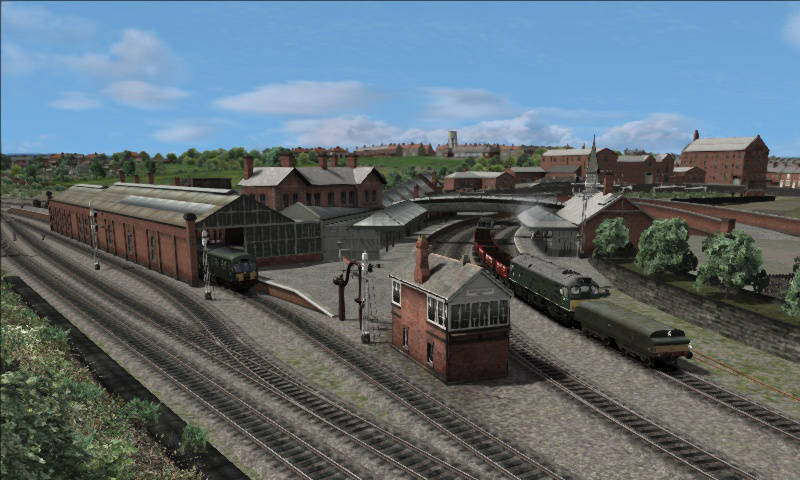
Bishop Auckland. A short coal train sporting a brake tender, which is surely unnecessary, passing through on its way to Barnard Castle keeps the DMU waiting at platform one- the only part of the station that survives.
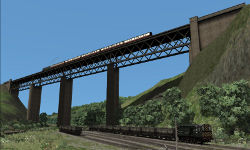
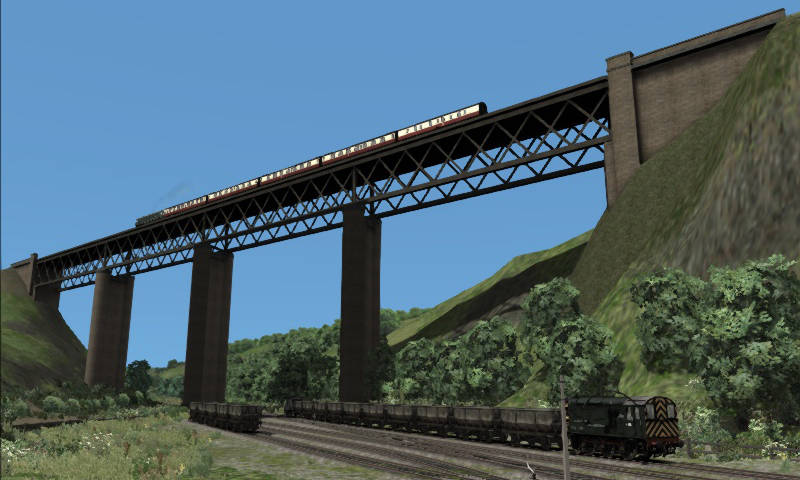
Lands Viaduct. A passenger train crosses the River Gaunless and the Haggerleases branch on its way to Barnard Castle and beyond. The Haggerleases line from West Auckland to Butterknowle was laid by the Stockton and Darlington Railway to serve the collieries there. Later the line to Barnard Castle branched from it and climbed to cross it and Cockfield Fell at Lands literally overshadowing the original branch. As the mines became less important the Haggerleases came to be known as the S&DR’s withered arm.
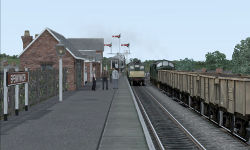
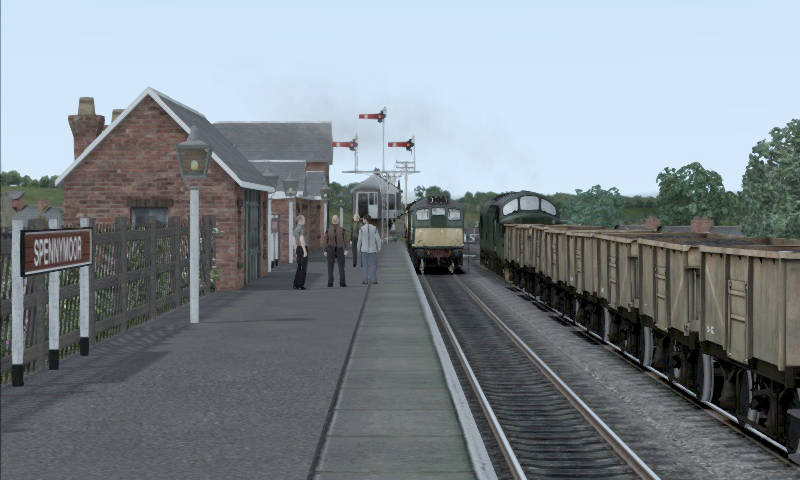
Spennymoor. A coal train waits for the incoming passenger train to clear the junction. Let us draw a veil over the fact that Spennymoor lost its passenger service in the '50s. Not a trace of the station survives today.
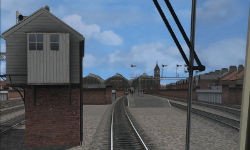
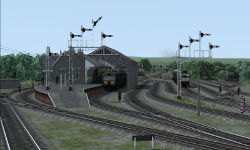
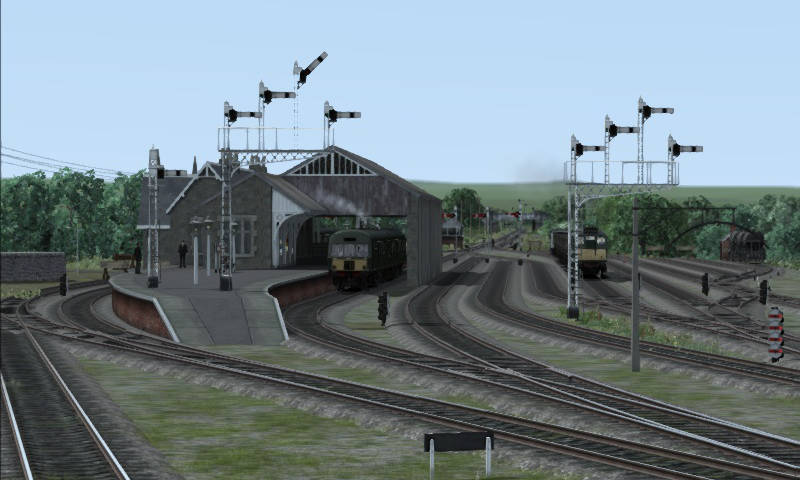
Barnard Castle. Barney was originally served by a station opened in 1856 with some fanfare but, when the Stockton and Darlington Railway’s hugely ambitious Stainmore Line through to Tebay was planned, it was soon realized that it was awkwardly situated and this through station opened in 1861. Not a trace survives the whole area being under an industrial estate though the viaduct carrying the line west (just beyond the signal box in the background) remains. The 1856 station has been adapted for housing.
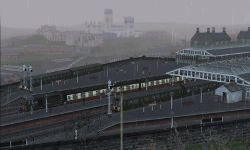
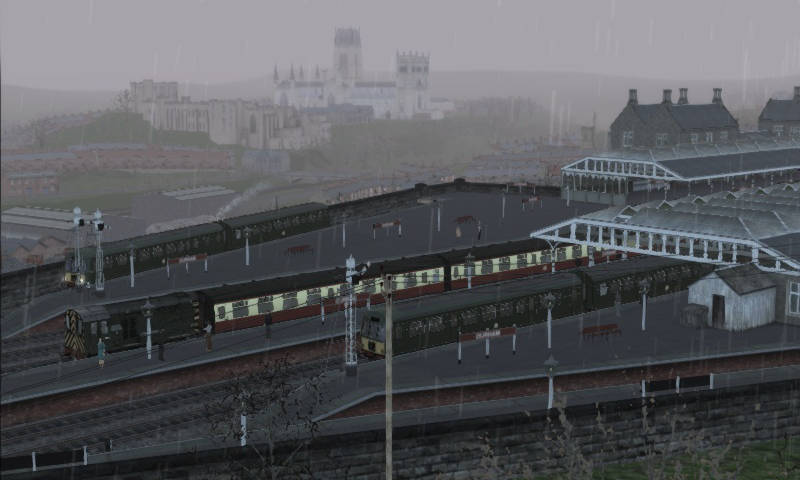
Durham. The (unlikely) station pilot moves some coaches and local services wait in the bay platforms on a dreary day. Durham had several bays at both ends but only the through platforms remain.
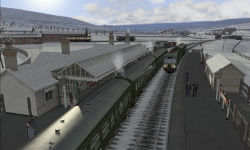
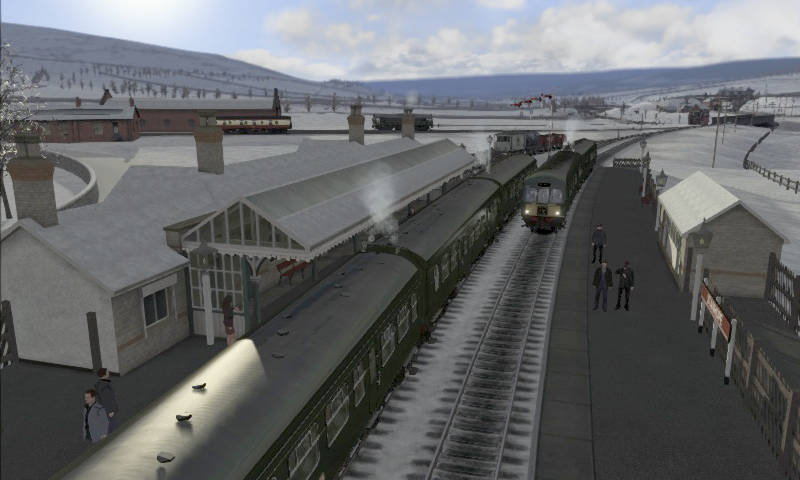
Stanhope. Services meet on a Winter's day. There was a steelworks at Wolsingham and a cement works at Eastgate both served by the railway. Some idea of how busy the line was can be gained by a look at the stations- the platforms can handle eight coach trains. Stanhope is now the westernmost station on the Weardale Railway.

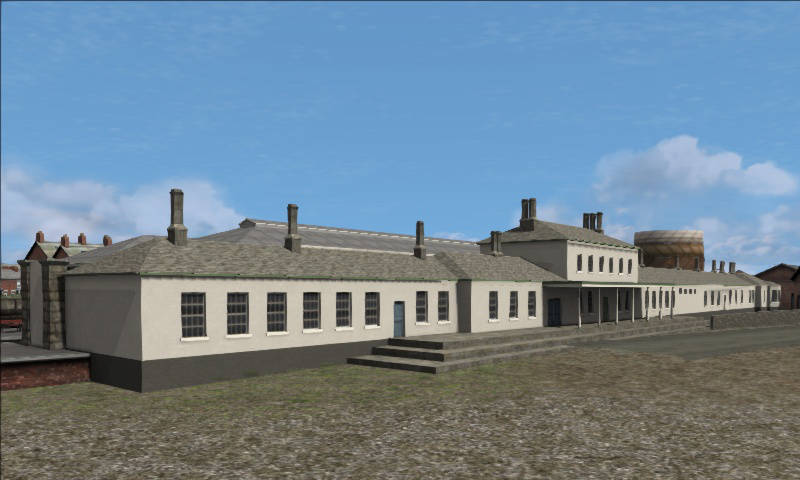
North Road Station, Darlington. The central section was opened by the Stockton and Darlington Railway in 1842 and the building was much expanded over the following 35 years. It now houses Darlington Railway Museum a.k.a. Head of Steam.
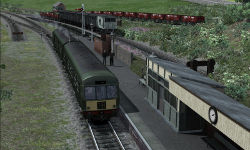
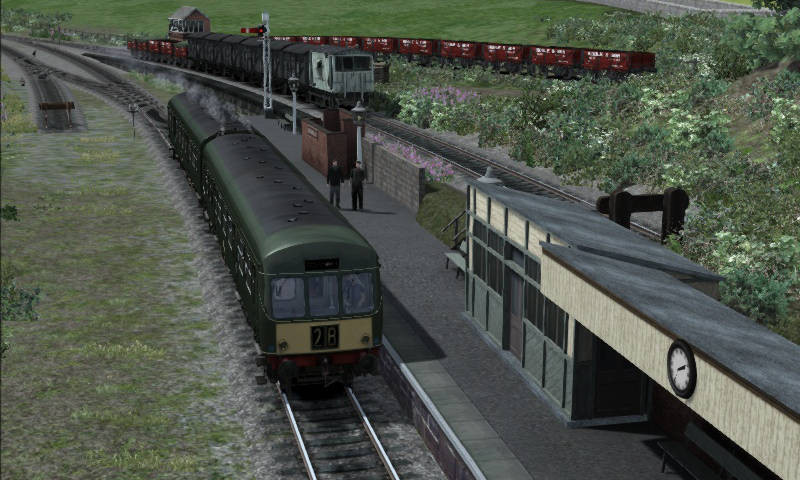
Broomielaw. Originally built as a private station for the Bowes-Lyon family at Streatham Castle. The buildings survive but in a dilapidated state.
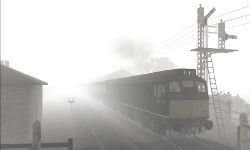

Heighington. A diverted passenger train looms out of the fog. Heighington (well done if you recognized it by the way) may not be the most celebrated station but the Stockton and Darlington Railway's first locomotive Locomotion No.1 was put on the tracks near here and, some 190 years later, Hitachi's new train factory opened nearby.
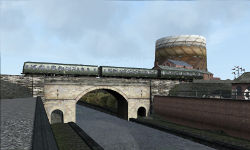
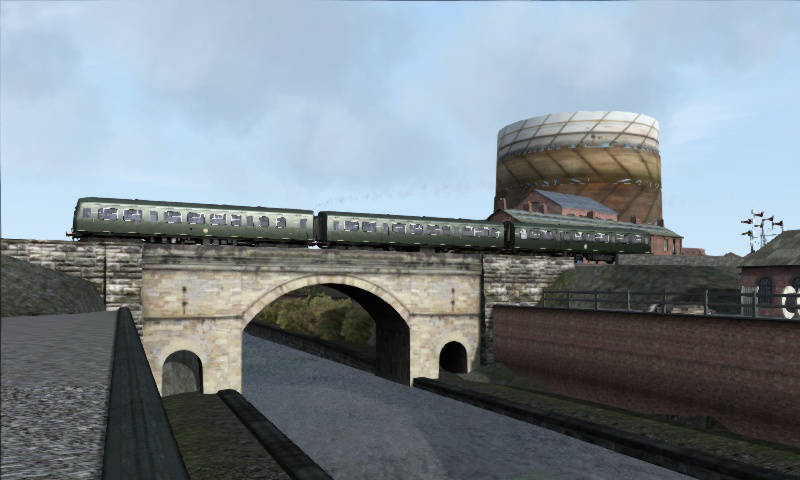
The Skerne Bridge. Ignatius Bonomi is cited as the world's first railway architect. His bridge across the River Skerne in Darlington featured on the five pound note from 1990 to 2003 and is central to John Dobbin's famous painting of the Stockton and Darlington Railway's opening day.
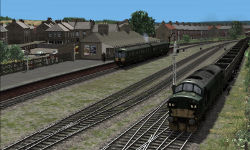
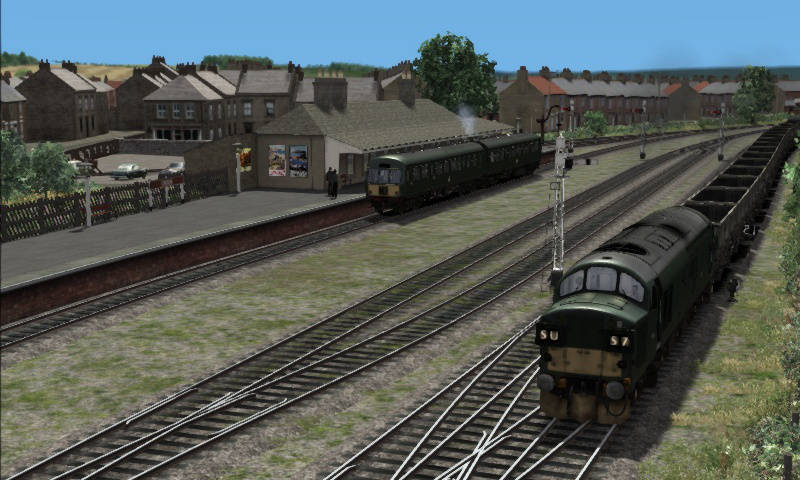
Crook. A passenger service waits for the signal as an EE type three passes with empty coal hoppers.
The promotional edition of Train Simulator 2016, which is the version available free to members of the Friends of Darlington Railway Museum in the offer here, came with an extra route normally available as a separate download: The Weardale and Teesdale Network in the '60s. Set just before the Beeching axe fell this is centred on Bishop Auckland with the lines to Darlington, Barnard Castle (and on to Middleton in Teesdale), Wearhead and Durham as well as the Darlington to Barney line, and the Haggerleases, Crook and Spennymoor branches (but not the ECML from Durham to Darlington). Freight and passenger scenarios explore most of the network. In spite of my Western Region upbringing it is this that most interested me. Indeed it prompted the original write up for the Friends of Darlington Railway Museum since the Museum is housed in the Stockton and Darlington Railway's North Road Station building which, of course, features in the game.
For anyone who remembers the railways as they were I imagine this will be very evocative and perhaps a little melancholic. I certainly find it so even having lived in this region only since the '80s. I never saw Bishop Auckland Station in its original triangular layout although I do remember wagons parked on Newton Cap viaduct just to the north perhaps while the tracks were being lifted... at least I thought I did. I read recently that the tracks were lifted in the late 60s. Even my memories go back nigh on 30 years so who knows- perhaps I saw lorries during construction of the road it carries now. Only part of platform one of the station remains, just enough to park a DMU. The rest has been swept away to make room for Morrisons, B&Q, Halfords and a car park. Apparently there's no room for the Weardale Railway though- it has a makeshift platform a couple of hundred yards or so to the west behind B&Q and past the Post Office depot and along a footpath and round a corner... No wonder it has trouble attracting passengers. But enough of that! Here Bishop Auckland Station is modelled in all its glory at the centre of a cluster of lines reaching across County Durham.
Since the Darlington to Stanhope stretch survives it offers an opportunity for comparison between the real world and the simulated. The stations I am most familiar with are Stanhope now on the Weardale Railway, Durham, Bank Top and, of course, North Road and all are instantly recognizable. Shildon and Heighington stand in marked contrast to the featureless platforms of today while closed stations like Piercebridge and Broomielaw compare well with photographs. Landmarks like Ignatius Bonomi's bridge over the River Skerne in Darlington or the long pedestrian bridge across the yard at Shildon, now at the western end of Locomotion, add to the sense of place. So much of the scenery was identifiable in fact that I was slightly surprised not to see some details such as Timothy Hackworth's cottage in Shildon or Stanhope's distinctive water tower. One has to stop somewhere of course but Spennymoor's distinctive Town Hall which would have been clearly visible from the station and the Railway pub which was next to it are both absent and it does seem odd to model the track to Barnard Castle freight station but not the station itself which does still exist after all albeit adapted for housing.
The route includes Classes 08, 25 and 37 loco's and Class 101 DMU as well as Mk1 coaches and wagons. There are seven scenarios installed with the route. You can drive the Class 101 DMU from Bishop Auckland to Darlington, Bishop to Wearhead and Barnard Castle to Bishop on runs which are all rated as easy. In the others you take the Class 25 on a passenger diversion from Darlington to Durham and freight runs from Durham to Barnard Castle, Shildon to Darlington gas works and Darlington to Middleton in Teesdale.
The Bishop to Darlington run on a fine day takes you along much of the western section of the original Stockton and Darlington Railway main line regarded, except by a few people in Manchester, as the world's first modern railway. This is the only section that is still part of the national network and anyone familiar with the route will be struck by the vast areas of track and infrastructure that just do not exist today.
Going the other way from Bishop to Wearhead takes you to what is now the Weardale Railway and beyond along what was County Durham's western-most line. Again, although the line beyond Witton-le-Wear was always single track, the contrast with today's pruned back system is remarkable especially at the complex Wear Valley Junction now just a curve. Whether it was the pleasant Autumn day the scenario is set in or the novelty of driving through familiar but different scenery I do not know but something about this scenario particularly appealed to me and, once I got to Wearhead, I would happily have changed ends and driven back again had that been asked of me.
Barnard Castle to Bishop Auckland takes place on a rainy day (you will need the wipers on) and climbs to cross Cockfield Fell before the long descent towards Bishop Auckland. The route is along another S&DR line not an inch of which exists today indeed quite a bit of the Bishop Auckland end has roads built over it. A highlight is the remarkable Lands Viaduct over the River Gaunless and the Haggerleases branch that ran alongside it.
The Class 25 passenger run non-stop from Darlington Bank Top to Durham on a foggy day imagines the main line being closed with trains diverted via Bishop though which main line passenger service was ever pulled by a Class 25 remains a mystery. In fact, as mentioned in the main overview of Train Simulator, scenarios will only work if the rolling-stock they specify is installed on your PC so these use only items that come with the Weardale and Teesdale Network. This makes certain that they will work but it is a bit odd to see express trains hauled by 25s and 37s. The fog is pretty convincing except in tunnels and demands that you keep on your toes. You get routed through the platform lane at North Road where I would have expected non-stoppers to take the avoiding lines.
The freight run from Durham to Barnard Castle is a low speed slog on a snowy night with a particularly gruelling climb up from West Auckland to Lands Viaduct before continuing over Cockfield Fell. This miles long climb goes from steep to very steep with a short section boasting an eye-watering 1:27 gradient!
Shildon to Darlington Gas Works (in filthy weather) I found particularly tricky. At the start you have to shunt the train together setting the points as you go which I am not sure the driver would ever do. Shunting is not especially difficult and neither is setting points but the schedule you have here is almost impossibly tight. If you can throw your train together in time you can only keep to it by running at the line speed of 45mph whereas I am pretty sure that unfitted freight trains were limited to 25mph. An item of interest is the inclusion of a brake tender in the train. Diesels are lighter than a steam locomotive of equivalent power and it was thought this would reduce their braking effectiveness on unfitted freights. These heavy tenders, no more than a dead weight with brakes, were created to add braking axles next to the loco'. I don't recall ever seeing one in service and thought they were soon withdrawn as unnecessary but have since been advised that they remained in use until the end of unfitted freight.
The last freight run is from sidings at Darlington Bank Top to Middleton in Teesdale. Again, once you pass Darlington North Road, you are on an S&DR route that no longer exists criss-crossing the River Tees on the way to Barnard Castle before branching from the Stainmore line past postcard pretty stations to your destination. This is rated as the most difficult scenario that comes with the Weardale and Teesdale add-on as standard but I am not sure why and it may be my favourite. Certainly I would find it hard to choose between this and the Wearhead run. To my mind both have the same pleasures as a leisurely drive through the countryside except that one is driving a train which is better. I would add that, once again, you are expected to drive an unfitted freight train at 45mph which is just wrong but Dovetail may claim simulator's licence. You get routed through North Road Station again rather than past it which is definitely wrong.
It seems odd that there are no scenarios for the Class 37 which was ubiquitous in this region or the 08 shunter which was just ubiquitous and none of them explores the lines to Crook or Spennymoor or the Haggerleases branch to Butterknowle- the "withered arm" of the S&DR. Happily the TS user base has done much to fill the gap. Scenarios are available that cover almost every inch of the network from the Workshop section of the Steam website driving all kinds of rolling stock.
It is worth noting that much of the area this route covers is rural. This means the scenery is less complex than it is in, for example, the West Rhine line with its large urban areas and extensive overhead electrification which adds a lot of detail that your PC's graphics system has to draw. Over most of the route the speed limit is 45mph meaning that the scenery does not have to be thrown around that quickly which must also relieve some of the load so this route is quite well suited to PCs that only just meet Train Simulator's requirements- such as those used by your Editor as described here.
The Weardale and Teesdale Network in the '60s is one of the most extensive and detailed DLCs available from Dovetail and one of the most highly rated. In 2015 I wrote that it would be some time before I got tired of it and that has yet to happen.